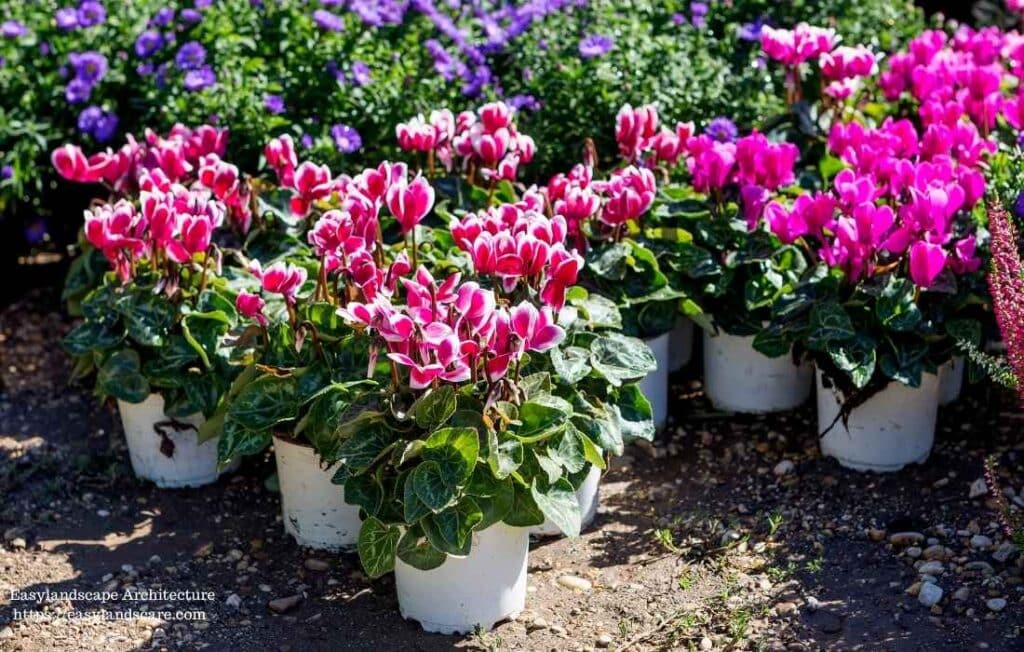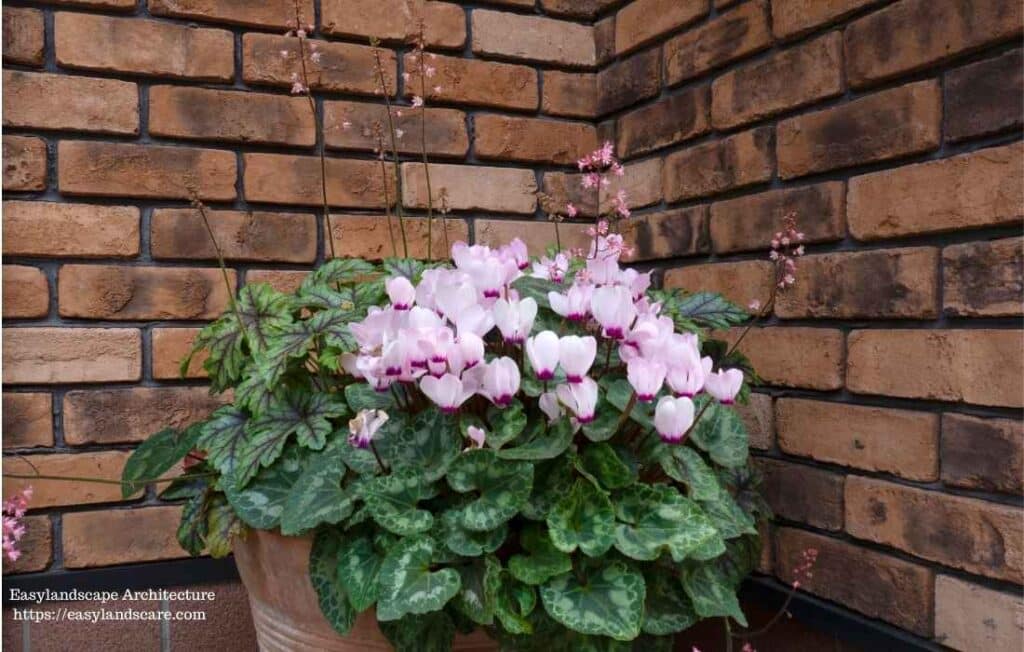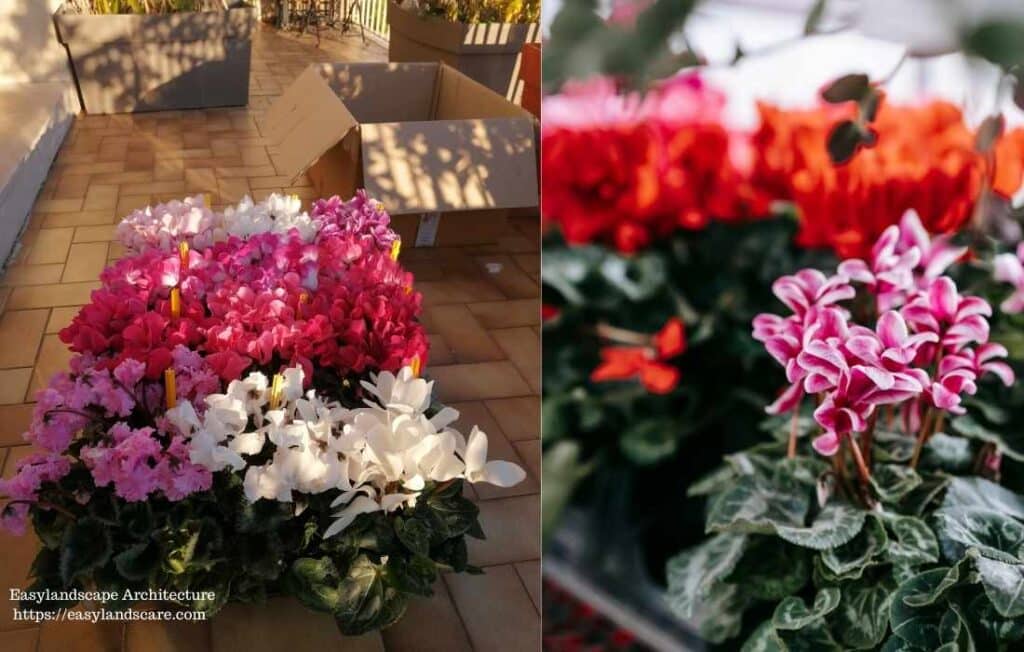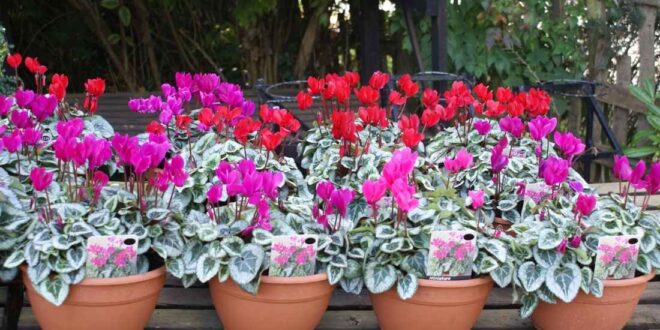Meet the Cyclamen Plant
Cyclamen (Cyclamen persicum) is a stunning flowering plant known for its elegant, upswept petals that come in a variety of colors, including pink, purple, red, white, and even bi-colors. These delicate blooms are often complemented by heart-shaped or kidney-shaped leaves adorned with intricate silver patterns. Cyclamen plants are a favorite among garden enthusiasts and indoor plant lovers, especially because they bloom during the cooler months, adding a vibrant splash of color to homes and gardens in late fall and winter. While they can be a bit finicky about their growing conditions, understanding the essentials of Cyclamen plant care will enable you to enjoy their long-lasting, cheerful blooms year after year.

This guide provides everything you need to know about Cyclamen plant care, including their light, watering, temperature, soil requirements, and tips on managing their natural dormancy. By following these tips, you can ensure your Cyclamen thrives and continues to brighten up your space during the darker months.
Why Choose a Cyclamen Plant?
Cyclamen plants are prized for their graceful flowers that rise above their beautifully patterned foliage. Their cool-season blooming period makes them a unique choice compared to other houseplants that typically flower in spring or summer. With a wide range of colors and patterns available, there’s a Cyclamen to suit every taste and décor style.

One of the most appealing aspects of Cyclamen is their ability to rebloom year after year. Although they have a dormant period, proper care during this time will ensure they come back stronger, producing even more flowers. If you’re looking for a plant that offers elegance, charm, and seasonal color, Cyclamen is the perfect choice.
Essential Tips for Cyclamen Plant Care

Light Requirements
Providing the right amount of light is critical for healthy growth and abundant blooms. Cyclamen thrive in bright, indirect light, making them ideal for indoor spaces with filtered sunlight.
- East or West-Facing Windows: These locations provide the perfect balance of light intensity.
- North-Facing Windows: Suitable during winter when light levels are lower.
- South-Facing Windows (with Protection): If placing your Cyclamen near a south-facing window, use sheer curtains to diffuse the sunlight and prevent scorching of the delicate leaves and flowers.
- Signs of Insufficient Light: If your Cyclamen receives too little light, it may develop leggy growth, weak stems, and produce fewer blooms.
Watering and Moisture
Proper watering is one of the most important aspects of Cyclamen plant care. Overwatering or incorrect watering techniques can lead to problems like root rot and fungal diseases.
- Water from the Bottom: The best way to water Cyclamen is to place the pot in a saucer of room-temperature water. Allow the plant to soak for 15-20 minutes until the topsoil feels damp, then remove the pot and let excess water drain completely.
- Avoid Wetting the Crown and Leaves: Watering from the top can wet the crown (the tuber’s top) and leaves, which increases the risk of rot and fungal infections.
- Keep Soil Slightly Moist During Blooming: During the blooming period, ensure the soil remains consistently moist but not waterlogged. Allow the top inch of soil to dry slightly between waterings.
- Reduce Watering After Blooming: Once the flowers fade and the leaves begin to yellow, gradually reduce watering to prepare the plant for dormancy.
Temperature Preferences
Cyclamen plants prefer cool temperatures, which help them thrive and extend their blooming period.
- Ideal Temperature Range: Keep your Cyclamen in a cool environment, ideally between 13-18°C (55-65°F).
- Avoid Heat Sources: Keep the plant away from radiators, heaters, and direct sunlight during the hottest parts of the day. High temperatures can stress the plant and shorten its bloom time.
- Good Air Circulation: Ensure proper airflow around your Cyclamen to prevent fungal diseases like gray mold.
Humidity Preferences
Cyclamen enjoy moderate humidity levels but can suffer in overly humid or excessively dry conditions.
- Increase Humidity Carefully: If your home is very dry, you can place the pot on a pebble tray filled with water to increase humidity. However, avoid misting the plant, as this can lead to moisture buildup on the leaves and crown, encouraging fungal issues.
- Balance is Key: Aim for moderate humidity while ensuring good air circulation to keep the plant healthy.
Soil Requirements
The right soil mix is essential for healthy root development and overall plant health.
- Well-Draining, Rich Mix: Use a potting mix that drains well and is rich in organic matter. A mix formulated for African Violets or a general-purpose mix amended with peat moss and perlite works perfectly.
- Good Aeration: Cyclamen roots need plenty of oxygen, so ensure the soil is not compacted.
- Repotting: Cyclamen generally don’t need frequent repotting. Repot every 1-2 years, preferably after the dormant period. When repotting, plant the tuber with its top just above the soil line.
Fertilizer
Fertilizing your Cyclamen correctly can enhance blooming and overall plant health.
- Light Feeding During Blooming: Feed your Cyclamen every 2-4 weeks with a balanced liquid fertilizer diluted to half strength.
- Avoid Over-Fertilizing: Excess fertilizer can lead to lush foliage at the expense of flowers.
- Stop Fertilizing Before Dormancy: Once the flowers fade and the leaves begin to yellow, discontinue fertilizing to allow the plant to enter its natural dormant phase.
Managing Dormancy in Cyclamen Plant Casre

Cyclamen naturally enter a dormant period after their blooming season, usually in late winter or early spring. Understanding how to manage this phase is crucial for long-term success.
- Recognizing Dormancy: During dormancy, the flowers will fade, and the leaves will yellow and die back. This is completely normal.
- Reduce Watering Gradually: As the foliage fades, gradually reduce watering until it stops entirely.
- Store the Tuber: Once the leaves have died back, you can leave the tuber in its pot or remove it for storage. Store it in a cool, dark, and dry place (15-21°C or 60-70°F) for 2-3 months.
- Restarting After Dormancy: In late summer or early fall, repot the tuber in fresh soil, keeping the top just above the soil line. Begin watering sparingly and place the plant in a cool, bright location. Increase watering as new growth appears.
Propagation in Cyclamen Plant Care

Cyclamen are typically propagated by seeds, which can be a slow and challenging process for home gardeners. While dividing the tubers is possible, it’s not recommended as it can damage the plant and reduce its chances of survival.
Troubleshooting Common Issues in Cyclamen Plant Care
Even with proper care, Cyclamen can face occasional problems. Here’s how to address them:
- Yellowing Leaves During Blooming: This is often caused by overwatering, poor drainage, or insufficient light. Adjust the watering schedule and ensure the plant receives adequate light.
- Drooping Flowers and Leaves: This can indicate underwatering or exposure to excessive heat. Water thoroughly (from the bottom) and move the plant to a cooler spot.
- Gray Mold (Botrytis): High humidity and poor air circulation can lead to fungal diseases. Remove affected parts immediately, improve airflow, and avoid wetting the foliage.
- Lack of Blooms: Insufficient light, warm temperatures, or the onset of dormancy can cause a lack of flowers. Ensure bright, indirect light and cool temperatures.
- Small Flowers: This may result from insufficient nutrients or light. Move the plant to a brighter location and consider light fertilization.
Tips for Successful Cyclamen Plant Care

- Provide bright, indirect light for optimal blooming.
- Water from the bottom to avoid wetting the crown and leaves.
- Maintain cool temperatures during the blooming period.
- Ensure good air circulation to prevent fungal diseases.
- Allow the plant to go through its natural dormant cycle.
- Use a well-draining potting mix for healthy root growth.
Conclusion
Caring for a Cyclamen plant may require a bit of attention to detail, but the rewards are well worth the effort. By following these Cyclamen plant care tips, you can enjoy their delicate, colorful blooms throughout the winter months. With proper light, watering, and temperature management, along with respect for their natural dormancy, your Cyclamen can thrive and rebloom year after year, bringing elegance and joy to your home even during the coldest seasons.

Whether you’re a seasoned gardener or a beginner, Cyclamen plants are a delightful addition to any indoor or outdoor space. Embrace their beauty and charm, and let their vibrant flowers brighten your winter days! To discover other indoor plants as beautiful as the spider plant, we recommend reading our article on the Best Indoor Plants: Top 15 Picks and Care Tips





